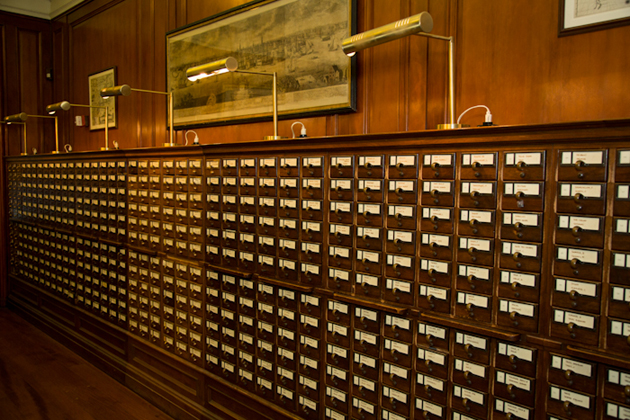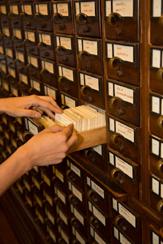Our Card Catalog Carries On
The Reference Room is home to one of our most prized possessions, the card catalog. Nearly every visitor remarks about the magnificent wooden case, often noting its outstanding craftsmanship and recalling its bygone function. Though the card catalog has not been updated since 1989, our catalog case is far from obsolete.

Prior to card catalogs, libraries relied on printed catalogs, which were quite expensive and time-consuming to publish. Considerable time passed between the printings of successive catalogs, and it was commonplace for printed catalogs to be outdated by the time the libraries received them from the printers. In order to maintain an up-to-date record of the library’s holdings, librarians relied on slips of paper or cards to transcribe individual entries for their newest accessions. These slips (“slip catalogs”) and cards were then filed in boxes, thereby laying the groundwork for the card catalog system.
The first library to introduce a card catalog exclusively for public use was Harvard University Library in 1862. Printed catalogs continued to be issued until the 1870s, but by the end of the 19th century virtually every library in the United States had adopted public card catalogs. Armed with a call number, library users could now physically locate books on the shelves without the aid of a librarian.
The catalog case that stands in our Reference Room was purchased on April 3, 1937 from Remington Rand, Inc. It shipped by truck from Ilion, NY on June 17th of that year and has since been on the west wall of the Reference Room. According to the invoice, the wooden piece was purchased for $1900 (equivalent to about $31,406 today). This same year, Edith Hall Crowell became the first female Head Librarian. One of Miss Crowell’s first projects was to re-catalog the Library’s collection according to the Dewey Decimal Classification System (replacing Charles Cutter’s “dictionary method.”)
A familiar sight to older generations of Library users, the card catalog is still the starting point for research by some of our members. Many of the call numbers still do correspond to books still on the shelves in our stacks. Assistant Head Librarian Carolyn Waters befittingly discusses our Reference Room catalog case in a paper she wrote for library school about her first encounter with the NYSL:
The Library only stopped adding cards to the physical card catalog in 1989, though changes to the physical records continued till as recently as 1998. It was truly a pleasure to see that the beautiful, massive wooden card catalog remains standing in the first floor Reading Room. My personal thoughts about seeing the catalog were echoed by the Circulation Manager [Jane Goldstein], who told me that if they removed the card catalog, they’d have to cart the librarians out with it! As it turns out, the physical catalog still has significant value, as many of the rare books in the library’s collection are still not updated in the online catalog, and therefore provides the only record of some of the holdings.
Since Carolyn’s first visit in 2006, two rare book collections have been entirely cataloged, the Sharp Collection and the Hammond Collection. Laura O'Keefe, Head of Special Collections and Cataloging, is currently completing the cataloging of John Winthrop Jr.’s Collection.
For further reading about library history in the United States, check out Kenneth Carpenter’s Institutions of Reading: the Social Life of Libraries in the United States, available both in print and as an e-book through Project Muse. To read more about the NYSL during the 20th century, peruse our beloved Marion King’s Books and People. Or browse Stack 11 under the call number 027 and see what might catch your eye.

If you’re interested in taking a trip down memory lane, stop in the Reference Room and try looking for your favorite classic in the card catalog. If you’re looking for a work of fiction, you can search either by the author (Capote, Truman) or the title Breakfast at Tiffany’s. You can do the same for nonfiction if you have a particular book in mind, or try searching by subject (e.g. “World War I”). It’s likely you’ll discover that the call number still pertains and then you can find the book in our open stacks! Happy searching!


Disqus Comments